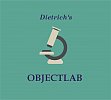Dietrich‘s laboratory for computer-based modelling, experiments and wear in objectarchaeology (OBJECTLAB)

The Dietrich Laboratory was established as part of the laboratory of the Institute of Prehistoric Archaeology and Medieval and Modern Archaeology within her Heisenberg Funding by the German Research Foundation (DFG). The laboratory of the Institute of Prehistoric Archaeology and Medieval and Modern Archaeology, funded by the state of Saxony-Anhalt and the Martin-Luther-University and set up 2014 by Professor François Bertemes comprises also facilities for teaching and for the preparation of excavation finds, restoration and conservation (ceramics and metal).
Using an integrative, systematising research approach based on modern 3D documentation techniques in combination with microscopy, computer-based usage simulations and experimental programmes as well as contextual analyses of finds, including residue analyses of artefact surfaces, artefacts are examined with regard to their production and use in complex systems. The focus of the current projects is on the Neolithic and Neolithisation as a disruptive event in the technological development of humankind, but other epochs are also being investigated. The main cooperation partners are the State Office for Archaeology of Saxony-Anhalt (Prof. Dr Harald Meller), the Austrian Archaeological Institute (Prof. Dr Barbara Horejs) and the Geometric Data Analysis Research Group at the Zuse Institute Berlin (Dr Christoph von Tycowicz).
Analyses and methods:
- 3D modelling of artefacts through scans and photogrammetry
- Analysis of deformations caused by the use of artefacts; Geometric Morphometry; Modelling of wear and simulation of intensity of use
- Experiments; experimental programmes focusing on stone artefacts, axes and adzes, grinding stones, lithic tools) in collaboration with the TraceR laboratory of Morepos, Leiza (Dr Joao Marreiros)
- Wear analysis: macro and microscopic analyses of surfaces
- Residue analyses on surfaces (phytoliths, starch, minerals, burnt crusts)
- Context-based functional interpretation
Our current projects:
1. Axes/adzes and grinding stones as tools of the Neolithisation in Central Europe. An integrative approach to functional analysis through Geometric Morphometrics, Use-Wear Analyses and Experimental Archaeology (WEAR)
2. Setting a methodology for the development of functional studies on archaeological objects". PI PD Dr Laura Dietrich
3. How did bread come to Central Europe? Investigations into the role of the Neolithic settlement of Brunn am Gebirge near Vienna in the spread of the eating habits of Europe's first farmers using the grinding stones LINK to the project
4. The Neolithic Stone Axes from Çukuriçi Höyük. Artefacts, use-wear and 3D visualisation
5. Excavations in Eilsleben: living at the edge of the Neolithic world of Central Europe
Head of the laboratory: PD Dr Laura Dietrich (3D modelling, photogrammetry, microscopy, trace and residue analysis, experiments)
Lohengrin Baunack: PhD-Project WEAR (Neolithic), experimental archaeology, stone axes, 3D- modeling, laser scanning, geometric morphometrics.
Christina Ullmann: PhD-Project WEAR (Neolithic), grinding stones, fragmentation.
Marina Eguíluz Valentini: Project Wear, use-wear, stone axes, antler axes.
Eva-Lotta Biesalski: Project Eilsleben (Neolithic), data management, phytolith analyses.
Elias Haußner: 3D-modeling, laser scanning, photogrammetry.
Lorenz Förtig: Master Thesis, Project Korça-Ebene (Neolithic) and Project Eilsleben.
Cooperations: Alexander Minnich (Postdoc), Project Brunn (Neolithic)



